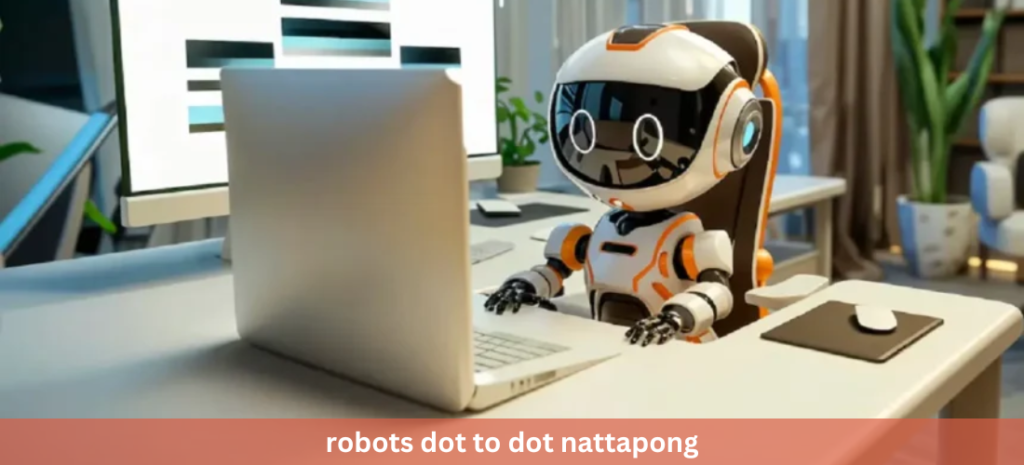
Understanding Robots dot to dot nattapong : A Comprehensive Guide
In the world of robotics and automation, robots dot to dot nattapong is a term that has gained immense popularity, offering a new way for individuals to engage with machines on an intuitive level. As robotics becomes more integrated into our daily lives, understanding the intricacies of robot design, programming, and control mechanisms is crucial. This article delves deep into robot dot to dot systems, exploring their relevance, applications, and potential for future developments.
Origins of Robots Dot to Dot Nattapong

The concept of robots dot to dot nattapong, is relatively new and can be linked to innovations in interactive design, robotics education, and simplified programming techniques. While the exact origins of the term are not widely documented, the idea of “dot to dot” in robotics is often associated with user-friendly methods for controlling and programming robots through simplified visual interfaces, similar to connecting dots in a puzzle.
The name Nattapong, often associated with robotics developments, is likely linked to specific individuals or research groups who have contributed to the evolution of these methods. One possibility is that it refers to Nattapong Charoenkitkarn, a researcher known for his work in automation and robotics. Robots dot to dot nattapong has been involved in creating accessible robotic systems that could be controlled by non-experts, aligning with the principles of “dot to dot” interfaces where tasks are simplified into step-by-step processes.
In essence, the robots dot to dot nattapong concept may have emerged as part of the growing trend to make robotics more accessible to people without technical backgrounds, by developing intuitive control systems that resemble the simplicity of connecting dots in a sequence. The work of innovators like Nattapong would be instrumental in promoting this vision, helping shape the way people engage with and operate robots today.
What is Robots Dot to Dot?
Robots dot to dot nattapong is a concept that focuses on the visual and interactive design of robotic systems. Just like the traditional dot-to-dot puzzles, where one connects numbered dots to reveal an image, robots dot to dot applies this analogy to robotic mapping, programming, and control. In essence, it is about creating simplified interfaces and systems where users can interact with machines, either physically or through software, by “connecting the dots” in a sequence of actions or inputs.
This method allows non-experts to control robots in ways that previously required specialized knowledge. The user-friendly nature of robots dot to dot nattapong systems reduces the complexity of robot control and makes the technology more accessible to broader audiences.
Read Also : Jaidyn Alexis Height: Discover the Model’s Stature and Its Impact on Her Career
Key Features of Robots Dot to Dot Systems
1. Simplified Control Mechanisms
One of the core aspects of robots dot to dot systems is their ability to streamline complex robotic control into more intuitive actions. These systems often rely on graphical user interfaces (GUIs), where users can input commands in a dot-to-dot style interface. Instead of writing complicated code, operators can guide a robot’s movements or actions by connecting a series of pre-defined nodes or points.
This reduction in complexity democratizes robotics, allowing people from various educational backgrounds to engage with and operate robotic systems without needing to master complex programming languages or technical systems.
2. Versatile Applications
From industrial automation to education and entertainment, the robots dot to dot nattapong approach finds applications across multiple sectors. In manufacturing, for instance, workers can program robots to follow specific tasks by simply connecting task points on a digital interface, streamlining production lines. Similarly, in the educational sector, students can learn robotics principles in a hands-on manner by guiding robots through simple, interactive dot-to-dot interfaces.
The versatility of this method also extends to service industries, where robots can be programmed to perform routine tasks such as cleaning, sorting, or delivering items. These systems, by being user-friendly, allow companies to employ robots without the need for expensive programming experts.
3. Educational Tool for Robotics Learning
Robots dot to dot systems are particularly valuable in educational environments. With the growing emphasis on STEM education, schools and learning institutions are using these systems to teach students the basics of robotics, programming, and engineering. By simplifying the learning process, students are able to quickly grasp complex concepts without feeling overwhelmed by technical details.
Furthermore, the hands-on, interactive nature of dot-to-dot systems fosters engagement and curiosity, encouraging more students to pursue careers in robotics and automation.
Why Robots Dot to Dot is the Future of User Interaction
The future of robotics lies in ease of use and accessibility. Robots dot to dot represents a significant leap towards making robotic systems more intuitive and user-friendly. The advantages of this system are not only evident in current applications but also in its potential for expanding into more areas such as personal robotics, healthcare, and smart homes.
1. Accessibility and Democratization of Robotics
One of the most transformative aspects of robots dot to dot nattapong is its potential to democratize robotics. As the world moves towards more automated systems, the ability for non-specialists to interact with robots will be crucial. These systems lower the barrier to entry for individuals and companies who may not have the resources or expertise to implement more complex robotic technologies.
2. Integration with Artificial Intelligence (AI)
Robots dot to dot nattapong systems are increasingly integrating with AI technologies to provide more responsive and adaptable robotic solutions. By combining AI-driven decision-making processes with the intuitive interface of dot-to-dot control, robots can now adapt their movements and actions based on real-time data, user preferences, or environmental conditions.
For example, a robot in a factory could automatically adjust its path based on changing production requirements, or a healthcare robot could modify its assistance to a patient based on their current medical condition. The integration of AI further enhances the flexibility and efficiency of robots dot to dot nattapong, opening the door to even more sophisticated applications.
3. Scalability and Customization
As robots dot to dot systems continue to evolve, one of their key advantages is their scalability. These systems can be adapted for small-scale applications, like educational robots, or large-scale industrial automation systems. Additionally, customization options allow users to tailor robotic systems to their specific needs, ensuring that the technology remains relevant in a variety of contexts.
For instance, a company may use a robot dot to dot system to automate its warehouse logistics, while a school may use the same underlying technology to teach students basic programming skills. This scalability makes robots dot to dot nattapong systems an attractive option for a wide range of users.
Challenges and Limitations of Robots Dot to Dot
While robots dot to dot nattapong presents numerous benefits, there are also challenges that need to be addressed.
1. Limited Flexibility in Complex Tasks
One of the primary limitations of robots dot to dot nattapong is that they may not be as effective for highly complex tasks that require detailed programming or intricate decision-making processes. Although AI integration is helping to bridge this gap, some tasks still require manual coding and precise control that may not be achievable through a simple robots dot to dot nattapong interface.
2. Dependence on Pre-Programmed Inputs
Robots dot to dot nattapong rely heavily on pre-programmed actions and inputs. While this makes them user-friendly, it also means that users are limited to the options provided within the system. Customizing actions beyond the pre-set inputs may require more advanced programming knowledge, which could limit the system’s accessibility for some users.
3. Cost and Technical Infrastructure
Implementing robots dot to dot nattapong in large-scale operations, especially in industries like manufacturing, requires significant technical infrastructure and investment. This could be a barrier for smaller companies or organizations that do not have the capital to invest in such systems. Additionally, ongoing maintenance and updates are essential to keep the systems running smoothly, adding to the long-term costs.
Applications of Robots Dot to Dot Nattapong
The robots dot to dot nattapong concept, particularly in the context of Nattapong’s work, encompasses a range of innovative applications that leverage intuitive, user-friendly interfaces for interacting with robotic systems. Here’s a detailed look at some of the key applications of this approach:
1. Educational Robotics
Robots dot to dot nattapong systems are extensively used in educational settings to teach students the fundamentals of robotics and programming. By simplifying the interaction with robots through visual, dot-to-dot interfaces, students can easily understand and engage with robotic systems. These systems enable learners to:
- Program Robots: Students can control robots by connecting nodes or points on a graphical interface, making complex programming concepts more accessible.
- Develop Problem-Solving Skills: Engaging with these systems helps students develop critical thinking and problem-solving skills as they design and test robotic behaviors.
- Foster Interest in STEM: The intuitive nature of dot-to-dot robotics encourages students to explore careers in science, technology, engineering, and mathematics (STEM).
2. Industrial Automation
In industrial environments, robots dot to dot nattapong systems simplify the programming and control of robotic arms and automated machinery. Key applications include:
- Streamlined Programming: Operators can set up robotic tasks by connecting dots representing different actions or waypoints, reducing the need for extensive programming knowledge.
- Improved Efficiency: By simplifying the setup process, these systems can speed up the deployment of robots in production lines, leading to increased efficiency and reduced downtime.
- Customizable Workflows: Businesses can easily adapt robotic systems to new tasks or production requirements by modifying the dot-to-dot configurations.
3. Healthcare and Assistive Robotics
In the healthcare sector, robots dot to dot nattapong systems are employed to enhance patient care and assist with medical procedures:
- Patient Assistance: Robots designed to assist patients with mobility issues can be controlled through dot-to-dot interfaces, making it easier for caregivers to program and manage their movements.
- Rehabilitation: In rehabilitation centers, robotic systems that support patient recovery can be adjusted and programmed using intuitive dot-to-dot methods, facilitating personalized treatment plans.
- Medical Automation: These systems can automate tasks such as dispensing medication or performing routine diagnostics, improving accuracy and efficiency in healthcare settings.
4. Consumer and Entertainment Robotics
Robots dot to dot nattapong interfaces are also applied in consumer robotics and entertainment, where user-friendliness is crucial:
- Home Robotics: Consumer robots, such as smart vacuum cleaners or lawn mowers, can be programmed using dot-to-dot interfaces to perform specific tasks around the home.
- Interactive Toys: Educational and interactive toys use similar concepts to engage children in robotics and programming activities, fostering creativity and learning through play.
- Entertainment Applications: In the entertainment industry, dot-to-dot systems enable users to interact with robots in immersive experiences, such as robotic exhibits or interactive shows.
5. Research and Development
Researchers and developers utilize robots dot to dot nattapong systems to prototype and test new robotic technologies:
- Rapid Prototyping: Researchers can quickly design and test new robotic behaviors or applications using simplified dot-to-dot interfaces, accelerating the development process.
- User Testing: These systems facilitate user testing by providing an easy-to-understand interface for controlling and interacting with experimental robots.
- Innovation: The intuitive nature of dot-to-dot systems encourages experimentation and innovation, leading to new discoveries and advancements in robotics.
6. Service Industry
In the service industry, robots dot to dot nattapong systems streamline operations and enhance customer experiences:
- Robotic Assistants: Robots in service roles, such as receptionists or concierge robots, can be programmed to perform tasks like answering questions or guiding guests using dot-to-dot interfaces.
- Automated Services: Systems for automating routine tasks, such as food delivery or cleaning, benefit from the ease of use provided by dot-to-dot programming.
- Customer Interaction: These systems improve the interaction between robots and customers, making service robots more adaptable and responsive to user needs.
Future Prospects robots dot to dot nattapong
The future prospects of robots dot to dot nattapong, especially within the framework of innovations associated with Nattapong, are promising and indicative of significant advancements in robotics and automation. As the field evolves, several key areas are poised for development and enhancement:
1. Enhanced User Interfaces
Future iterations of Robots Dot to Dot systems will likely see improvements in user interfaces, making them even more intuitive and accessible. Advances in graphical user interfaces (GUIs) and augmented reality (AR) will allow users to interact with robotic systems through more immersive and interactive experiences. These advancements could include:
- 3D Visualizations: Utilizing 3D models and AR to provide users with a more detailed and interactive view of robot tasks and workflows.
- Voice and Gesture Controls: Incorporating voice commands and gesture recognition to complement the dot-to-dot interface, making it easier to control robots in various environments.
2. Integration with Artificial Intelligence
The integration of Artificial Intelligence (AI) with dot-to-dot robotics will enhance the capabilities and adaptability of these systems. AI can enable robots to:
- Learn and Adapt: Robots will be able to learn from user interactions and environmental conditions, allowing them to adapt their behaviors and improve their performance over time.
- Predictive Maintenance: AI algorithms will predict and address potential issues before they occur, improving the reliability and longevity of robotic systems.
- Personalized Interactions: AI will enable robots to tailor their actions and responses based on individual user preferences and needs, creating a more personalized experience.
3. Expansion into New Industries
As Robots Dot to Dot technology continues to advance, its applications will expand into new and diverse industries. Potential areas for growth include:
- Agriculture: Robots equipped with dot-to-dot interfaces could assist in tasks such as planting, harvesting, and monitoring crops, increasing efficiency and reducing labor costs.
- Construction: In construction, robots could be programmed to perform tasks like surveying, material handling, and even building assembly using simplified control systems.
- Space Exploration: The principles of dot-to-dot robotics could be applied to space missions, allowing for the remote control and operation of robotic systems on extraterrestrial surfaces.
4. Advancements in Robotics Education
The future of Robots Dot to Dot in education will focus on enhancing the learning experience for students and professionals alike. Innovations may include:
- Curriculum Integration: More educational institutions will integrate dot-to-dot robotics into their STEM curricula, providing students with hands-on experience and practical skills.
- Online Learning Platforms: Online platforms and simulators will offer interactive dot-to-dot robotics training, enabling learners to experiment with robotic programming from anywhere in the world.
- Collaborative Learning: Tools and platforms that facilitate collaborative learning and project-based activities will become more prevalent, encouraging teamwork and innovation.
5. Improved Customization and Scalability
Future developments in Robots Dot to Dot technology will enhance customization and scalability, allowing users to tailor robotic systems to their specific needs:
- Modular Designs: Robots will be designed with modular components that can be easily customized or replaced, allowing for flexible and scalable solutions.
- Cloud-Based Control: Cloud computing will enable users to control and monitor robots remotely, providing greater flexibility and scalability in various applications.
6. Ethical and Regulatory Considerations
As the use of Robots Dot to Dot systems becomes more widespread, ethical and regulatory considerations will play a crucial role in shaping the future of robotics. Key areas of focus include:
- Data Privacy and Security: Ensuring that user data and interactions with robotic systems are protected and secure will be essential in maintaining user trust and compliance with regulations.
- Ethical Use: Establishing guidelines and standards for the ethical use of robots, particularly in sensitive areas such as healthcare and personal assistance, will be important for ensuring responsible development and deployment.
- Regulatory Frameworks: Developing and implementing regulatory frameworks that address the challenges and opportunities of dot-to-dot robotics will support safe and effective integration into various industries.
Conclusion
The robots dot to dot approach marks a significant shift in how we interact with robotic systems. Its simplicity, scalability, and user-friendly design make it a powerful tool for various industries and educational purposes. As we move forward into a more automated world, dot-to-dot systems will likely play a crucial role in making robotics more accessible to everyone, from large corporations to individual users.


